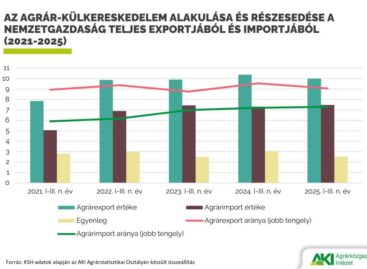Live cattle exports decreased by 18 percent in 2023
According to AKI’s slaughter statistics data, cattle slaughter in January 2024, expressed in live weight, decreased by 13 percent compared to January 2023. Cows, which accounted for more than two-thirds of all slaughters, were slaughtered by about 20 percent, heifers by 8 percent less, while bulls increased by almost 11 percent.

Based on KSH data, Hungary’s live cattle exports in 2023 were 18 percent lower than in 2022. The main partners were Kosovo, Croatia, Austria, Turkey and Italy. Hungary’s live cattle imports increased by 77 percent, more than half of the live cattle came from Denmark, Austria and Germany.
The volume of beef exports decreased by almost 20 percent and the value by 23 percent
The volume of beef imports decreased by 9 percent and the value by about 4 percent in the observed period. According to the AKI PÁIR data, the producer price of young bulls was HUF 757/kilogram of split hot weight in February 2024, which did not change significantly compared to the average price of the same month in 2023. The price of the slaughter heifer decreased by 4 percent and the price of the slaughter cow by 7 percent during the examined period. According to KSH data, the consumer price of beef steak was 7 percent higher (HUF 4,580/kilogram) in February 2024 than a year earlier.
AKI PÁIR
Related news
Agricultural foreign trade surplus decreased in the first three quarters of 2025
🎧 Hallgasd a cikket: Lejátszás Szünet Folytatás Leállítás Nyelv: Auto…
Read more >Milk powder and butter prices fell on the world market
🎧 Hallgasd a cikket: Lejátszás Szünet Folytatás Leállítás Nyelv: Auto…
Read more >The value of agricultural output is expected to increase by around 6 percent in 2025
🎧 Hallgasd a cikket: Lejátszás Szünet Folytatás Leállítás Nyelv: Auto…
Read more >Related news
How do young adults celebrate?
🎧 Hallgasd a cikket: Lejátszás Szünet Folytatás Leállítás Nyelv: Auto…
Read more >Vajda-Papír celebrates Ooops!’s 15th anniversary with a hybrid AI campaign
🎧 Hallgasd a cikket: Lejátszás Szünet Folytatás Leállítás Nyelv: Auto…
Read more >Pre-holiday shopping at up to half price
🎧 Hallgasd a cikket: Lejátszás Szünet Folytatás Leállítás Nyelv: Auto…
Read more >






